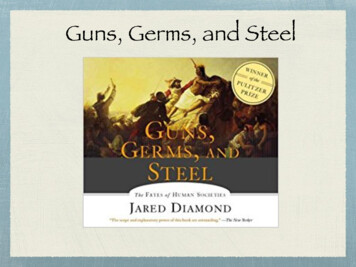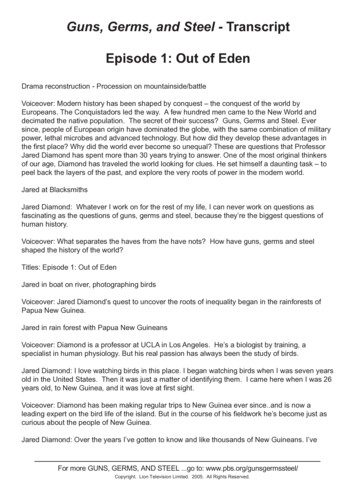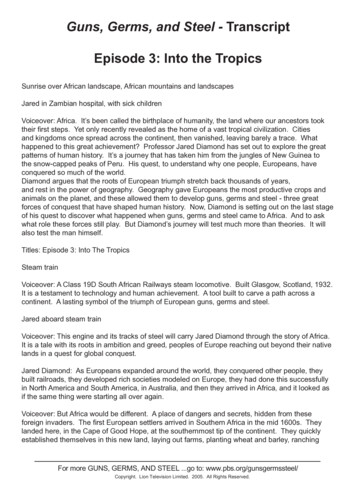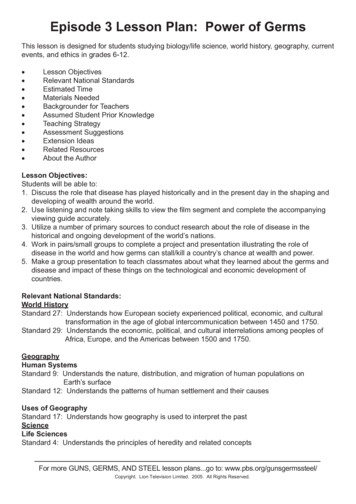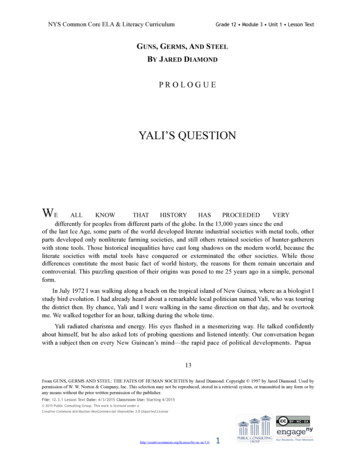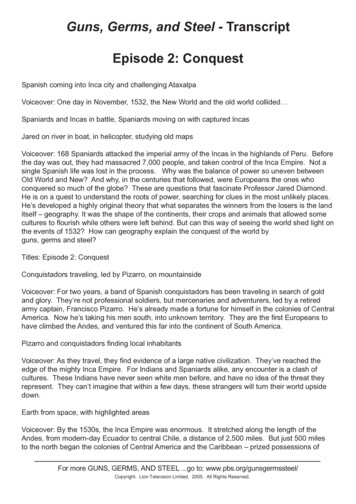
Transcription
Guns, Germs, and Steel - TranscriptEpisode 2: ConquestSpanish coming into Inca city and challenging AtaxalpaVoiceover: One day in November, 1532, the New World and the old world collided Spaniards and Incas in battle, Spaniards moving on with captured IncasJared on river in boat, in helicopter, studying old mapsVoiceover: 168 Spaniards attacked the imperial army of the Incas in the highlands of Peru. Beforethe day was out, they had massacred 7,000 people, and taken control of the Inca Empire. Not asingle Spanish life was lost in the process. Why was the balance of power so uneven betweenOld World and New? And why, in the centuries that followed, were Europeans the ones whoconquered so much of the globe? These are questions that fascinate Professor Jared Diamond.He is on a quest to understand the roots of power, searching for clues in the most unlikely places.He’s developed a highly original theory that what separates the winners from the losers is the landitself – geography. It was the shape of the continents, their crops and animals that allowed somecultures to flourish while others were left behind. But can this way of seeing the world shed light onthe events of 1532? How can geography explain the conquest of the world byguns, germs and steel?Titles: Episode 2: ConquestConquistadors traveling, led by Pizarro, on mountainsideVoiceover: For two years, a band of Spanish conquistadors has been traveling in search of goldand glory. They’re not professional soldiers, but mercenaries and adventurers, led by a retiredarmy captain, Francisco Pizarro. He’s already made a fortune for himself in the colonies of CentralAmerica. Now he’s taking his men south, into unknown territory. They are the first Europeans tohave climbed the Andes, and ventured this far into the continent of South America.Pizarro and conquistadors finding local inhabitantsVoiceover: As they travel, they find evidence of a large native civilization. They’ve reached theedge of the mighty Inca Empire. For Indians and Spaniards alike, any encounter is a clash ofcultures. These Indians have never seen white men before, and have no idea of the threat theyrepresent. They can’t imagine that within a few days, these strangers will turn their world upsidedown.Earth from space, with highlighted areasVoiceover: By the 1530s, the Inca Empire was enormous. It stretched along the length of theAndes, from modern-day Ecuador to central Chile, a distance of 2,500 miles. But just 500 milesto the north began the colonies of Central America and the Caribbean – prized possessions ofFor more GUNS, GERMS, AND STEEL .go to: www.pbs.org/gunsgermssteel/Copyright. Lion Television Limited. 2005. All Rights Reserved.
the Spanish empire. At the time, the Spanish king controlled a third of mainland Europe, butSpain itself had only recently become a unified state, having fought off 700 years of occupation byIslamic Moors.Pizarro’s home, with Jared walking around itVoiceover: It was still a rural society. Most of the conquistadors came from villages and smalltowns in the heart of the country; towns like Trujillo, where Pizarro grew up. He spent much of hischildhood here, working as a swineherd in the fields nearby. Today he’s remembered as a greatwarrior. His statue dominates the main square in Trujillo, and his family home has been turnedinto a museum. Jared Diamond has come here to explore the world of the conquistadors, andunderstand the secret of their success.Statue of PizarroJared Diamond: This is Francisco Pizarro, a Spaniard who conquered the most powerful state inthe New World, the Inca Empire. Why did Pizarro and his men conquer the Incas instead of theother way round? It seems like a simple question. The answer isn’t immediately obvious. Afterall, Pizarro started out as a rather ordinary person, and Trujillo here is a rather ordinary town. Sowhat is it that gave Pizarro and his men this enormous power?Pizarro and conquistadors travelingJared Diamond: Why am I so interested in Pizarro’s conquistadors? Because their story is such agrimly successful example of European conquest. And for 30 years I’ve been exploring patterns ofconquest.Voiceover: Jared Diamond is a professor at UCLA in Los Angeles. But most of his fieldwork hasbeen done in Papua New Guinea. His time there inspired him to explore the roots of inequalityin the modern world. To understand why some people have been able to dominate and conquerothers. Looking back thousands of years, he argues that farming gave some cultures anenormous head start, and those who were lucky enough to have the most productive crops andanimals became the most productive farmers. Agriculture first developed in a part of the MiddleEast known as the Fertile Crescent. Over time, crops and animals from the Fertile Crescentspread into North Africa and Europe, where they triggered an explosion of civilization. By the 16thCentury, European farms were dominated by livestock animals that had come from the FertileCrescent. None were native to Europe. They provided more than just meat. They were a sourceof milk and wool, leather and manure. And crucially, they provided muscle power.Mules pulling ploughs, Incas cultivating land as llamas look on, Conquistadors riding onto IncalandVoiceover: Harnessed to a plough, a horse or an ox could transform the productivity of farmland.European farmers were able to grow more food to feed more people, who could then build biggerand more complex societies. In the New World, there were no horses or cattle for farming. Allthe work had to be done by hand. The only large domestic animal was the llama, but thesedocile creatures have never been harnessed to a plough. The Incas were very skilled at growingpotatoes and corn, but because of their geography, they could never be as productive asEuropean farmers. Horses gave Europeans another massive advantage – they could be ridden.To the Incas, the sight of Pizarro’s conquistadors passing through their land is extraordinary.For more GUNS, GERMS, AND STEEL .go to: www.pbs.org/gunsgermssteel/Copyright. Lion Television Limited. 2005. All Rights Reserved.
They’ve never seen people carried by their animals before. Some think they are gods, thesestrange-looking men, part human, part beast. The horses that seemed so exotic to the Incas hadalready been used in Spain for 4,000 years. In an age before motorized transport, they allowedpeople to be mobile, and control their land.Jared watching Javier ridingVoiceover: When Javier Martin is not herding cattle, he gives displays of traditional horsemanship.Javier Martin: This style of riding is known as jimeta. The emphasis is on control andmaneuverability, using bent knees to grip the sides of the horse, and only one hand on the reins.Very different from the more formal style of medieval knights. By the 16th century, the jimeta wayof riding had become the dominant style of the Spanish cavalry. This is how the conquistadorswould have ridden their horses.Jared Diamond: It’s an amazing display of a big animal being controlled by a person,precise control, stopping and starting and turning. Javier told me that he has been ridingsince he was five years old, and when I watched this, I have a better understanding where theconquistadors were coming from. They were masters of these techniques, and they learned thesetechniques for working with bulls, but the techniques were also good in a military context as well,and I can see that this control would let you ride down people in the open. People who had neverseen horses before would have been absolutely terrified watching this. It would be strange andfrightening, and that’s even before one of these animals is rushing towards you, riding you down,about to lance you and kill you.Inca messenger running to give news to AtaxalpaVoiceover: News of the godlike strangers on their four-legged animals is taken by royal messengerto the emperor of the Incas, who’s camped in the valley of Cajamarca in northern Peru, guardedby an army of 80,000 men.Ataxalpa being beautifiedVoiceover: Ataxalpa is revered as a living god, a son of the sun itself. He’s in Cajamarca on areligious retreat, giving thanks for a series of recent military triumphs.Messenger giving Ataxalpa the newsVoiceover: When he hears about the progress of the Spaniards, he chooses not to have themkilled. Instead, he sends back a message. He invites them to join him in Cajamarca, as quickly aspossible.Messenger running to give replyEfrain Trelles, Historian: Ataxalpa wanted the Spaniards to come to Cajamarca and enter intoa trap, and to be sure that they would do so; he played like a psychological game with them,sending presents, asking them to come. Ataxalpa knew that the Spaniards were not gods. Theintelligence reports speak of people wearing wool on their faces, like a lamb or like an alpaca,they’re just like an animal. Then they went from one place to the other wearing on top of theirheads a little pot that has never been used for cooking.For more GUNS, GERMS, AND STEEL.go to: www.pbs.org/gunsgermssteel/Copyright. Lion Television Limited. 2005. All Rights Reserved.
You need to be crazy to walk with a pot, but you must be beyond salvation if you arrive to a campand you don’t use that pot to cook. Ataxalpa had an idea that these were sub-humans. Whatcould a few horsemen and a hundred or so Spaniards do to the powerful Inca? Virtually nothing.Art depicting Spanish in battleVoiceover: But Ataxalpa’s spies don’t realize that the Spanish are armed with some of the bestweapons in the world. At the time of the conquistadors, Spain had the biggest army in Europe,orchestrated from the imperial capital, Toledo. For more than 700 years the Spaniards had beenat war, fighting against the Moors and other European armies. There was an arms race in Europe.To survive, the Spaniards needed to keep up with the latest in weapons technology.Man and Jared firing and loading gunsVoiceover: By the 1530s, the Jacobus was an important part of the Spanish arsenal. Gunpowderhad originally come from China, but its use as a weapon was pioneered by the Arabs. InEuropean hands, guns became lighter and more portable, and were used for the first time by footsoldiers on the battlefield. The Jacobus was still a crude weapon, but would go on to change theface of warfare.Jared Diamond: To us moderns, this gun doesn’t seem useful for anything, it’s like a joke. Its aimis terrible, it takes a long time to reload, and while the shooter’s reloading it a swordsman wouldcome in and kill him, but the Incas hadn’t even gotten this far, and even this gun, with its soundand with the smell and with the smoke and with every now and then a person that it managesto kill, would have been terrifying to someone who had never seen this before. This would havebeen shock and awe, 1532 style.Sword smith at work as Jared watchesVoiceover: For all its bluster, the technology of gunpowder was still in its infancy. The real powerof the conquistadors lay elsewhere, with the production of steel. Toledo had some of the bestsword smiths in the world. But why were people here able to craft deadly steel weapons, while theIncas were still making simple bronze tools?Man handling swordJared Diamond: There was nothing innately brilliant about Europeans themselves that allowedthem to be the ones to make high quality swords. Just as with guns, swords were the result of along process of trial and error that began outside Europe. People started working with metal inthe Fertile Crescent 7,000 years ago, and because Europe is geographically close to the fertilecrescent, Europeans inherited this metal technology.But they took this technology on to a new level. European soldiers demanded stronger, longer,sharper swords.Jared Diamond: This is what a Toledo sword looks like when it’s finished. This particular one ismodeled on the sword that Pizarro carried. It’s a fearsome weapon.It’s used for stabbing and it’s also used for slashing, and I can easily understand how the personwielding the sword could kill dozens of people within a short time.Mike Loads, Historical Weapons Expert: Swords like this, rapiers, represented a high point ina very sophisticated metalworking technology. You think about what the qualities are that areFor more GUNS, GERMS, AND STEEL .go to: www.pbs.org/gunsgermssteel/Copyright. Lion Television Limited. 2005. All Rights Reserved.
needed in a sword. First of all, it has to be hard enough, the metal has to be hard enough to takea sharp edge, and that requires steel that is iron infused with carbon, and the more carbon you putinto the iron, then the harder the metal is. But if you make it too hard, then it’s brittle, and that’s nogood because as you hit somebody, your sword would break, and so you also need your swordto have a certain pliability, an ability to bend and spring back into shape. And it’s got by heatingit to certain temperatures, plunging it into cold water, immense amount of experimentation, it tookcenturies to get to the level of sophistication where you could get something so long and elegantand fine, and deadly as the rapier.SwordfightVoiceover: The rapier, with its extra long blade, was developed as a dueling weapon, but becameso fashionable in Renaissance Europe; it was the sword of choice for any aspiring gentleman.Mike Loades: The word rapier derives from the Spanish term “espara ropera”, and that meansdress sword. And for the first time in Spain, we start to see people wearing the sword with theireveryday clothing, their civilian dress, going about their everyday business. They didn’t do that inthe Middle Ages. This is something new in the 16th century, and it’s saying I have arrived, I am agentleman, I am upwardly mobile, and I claim ancestry from the knights of the Middle Ages. It wasvery much a symbol of the conquistadors’ aspiring greed. The thing that drove them through alltheir hardships, the thing that made them go to the Americas, was their lust for gold, their lust forself-advancement, and the rapier absolutely symbolized that overbearing avarice.Conquistadors traveling, looking across valley to huge town and massed troopsVoiceover: On November 15th 1532, Pizarro’s band of adventurers entered the valley ofCajamarca. They’ve been told that Ataxalpa is waiting for them here. But they’re not preparedfor the sight that greets them. In the hills beyond the town of Cajamarca is the imperial Incaarmy - 80,000 men in full battle order. The conquistadors’ own journals bear witness to their firstimpressions.Diary Reading: Their camp looked like a very beautiful city. We’d seen nothing like it in the Indiesuntil then, and it scared us, because we were so few and so deep in this land.Spanish entering Inca camp and being taken to AtaxalpaVoiceover: Pizzaro sends a party of his best horsemen into the heart of the Inca camp. They areled by Captain De Soto. They are gambling that Ataxalpa will allow them to pass through thecamp unharmed, and agree to meet them.Efrain Trelles: Soto’s visit had a very important psychological purpose; to intimidate the Incain front of his people. Challenging him with the horse. Ataxalpa at first didn’t react to Soto’spresence, as if nobody had entered the room. Once the, the horse comes eye to eye with theInca, the Inca is still calm, showing that the horse has no impact on him,calling Soto’s bluff. The captain advanced so close that the horse’s nostrils disturbed the fringe ofthe Inca’s forehead. But the Inca never moved. And then, after a brief silence comes Ataxalpa’sexplosion. He was telling them, the time has come for you to pay.I understand this as the time has come for you to pay with your lives. Soto I understand wasnervous enough to come back with fear to the, the camp, and as we know, the Spaniards spentFor more GUNS, GERMS, AND STEEL .go to: www.pbs.org/gunsgermssteel/Copyright. Lion Television Limited. 2005. All Rights Reserved.
the night before in extreme fear.Spaniards’ camp at nightVoiceover: The conquistadors had made their camp in the town of Cajamarca. Many of them arenow convinced they are facing oblivion. 168 soldiers, 1,000 miles from any other Spaniard, facingan army of 80,000 Incas.Diary Reading: Few of us slept that night. We kept walking the square, from where we could seethe campfires of the Indian army. It was a fearful sight, like a brilliantly star-studded night.Voiceover: Pizarro and his most trusted officers debate their options for how to deal with Ataxalpa.Some advise caution, but Pizarro insists their best chance is to launch a surprise attack the nextday. It’s a tactic that’s worked successfully in the past. Twelve years before Pizarro went to Peru,another famous conquistador, Hernan Cortez, had gone to Mexico and encountered anotherformidable civilization; the Aztecs. He conquered the country by kidnapping the Aztec leaderand exploiting the ensuing chaos. Cortez’s story was later published and became a bestseller, ahandbook for any would-be conquistador. It can still be found in the great library of SalamancaUniversity in Northern Spain.Jared Diamond: This wonderful library here can be thought of among other things as a repositoryof dirty tricks, because in these books are the accounts of what generals had been doing to othergenerals for thousands of years in the past and across much of Eurasia, and here from this librarywe have a famous account of the conquest of Mexico with all the details of what Cortez did tothe Aztecs and what worked. That was a model for Pizarro to give him ideas what exactly to tryout on the Incas, whereas the Incas without writing, had only local knowledge transmitted by oralmemory, and they were unsophisticated and naïve compared to the Spaniards because of writing.Voiceover: But if books were so useful, why couldn’t the Incas read or write? To develop a newsystem of writing independently is an extremely complex process, and has happened very rarely inhuman history. It was first achieved by the Sumerian people of the Fertile Crescent at least 5,000years ago. They pioneered an elaborate system of symbols called cuneiform, possibly as a way ofrecording farming transactions.Ever since, almost every other written language of Europe and Asia has copied, adapted or simplybeen inspired by the basics of cuneiform. The spread of writing was helped enormously by theinvention of paper, ink and moveable type, innovations that all came from outside Europe but wereseized upon by Europeans in the Middle Ages to produce the ultimate transmitter of knowledge– the printing press. The written word could now spread quickly and accurately across Europe andAsia. The modern world would be impossible without the development of writing.Jared studying mapsVoiceover: But there’s another part of the world where a new system of writing was inventedindependently. In Southern Mexico, at least 2,500 years ago, native people developed a way ofworking with symbols that involved into the Mayan script. But if the Maya had writing, why didn’tit spread south to the Andes and help the Incas become literate? For Diamond, the answer lies inthe shape of the continents.Jared Diamond: Here were Europe and Asia forming the continent of Eurasia, a giant continentbut it’s stretched out from east to west, and narrows from north to south. The American continentFor more GUNS, GERMS, AND STEEL .go to: www.pbs.org/gunsgermssteel/Copyright. Lion Television Limited. 2005. All Rights Reserved.
is long from north to south, narrow from east to west – very narrow at Panama where it narrowsdown to less than 100 miles. The two continents are of the same lengths, about 8,000 miles inmaximum dimensions, but Eurasia is 8,000 miles from east to west, and the Americas are 8,000miles from north to south, it’s as if these continents were rotated 90 degrees of each other.Voiceover: Diamond has already shown that crops and animals could spread easily east andwest across Eurasia. Because places the same latitude automatically share the same day lengthand a similar climate and vegetation. But the American continents were the opposite of Eurasia.A journey from one end of the Americas to the other is a journey from north to south, a journeythrough different day lengths, different climate zones, and dramatically different vegetation.These basic differences hindered the spread of crops and animals as well as people, ideas andtechnologies. The people of the Andes were chronically isolated, without access to writing oralmost any other innovation from elsewhere in the Americas. By contrast, Pizarro and his menwere geographically blessed. As Spaniards, they enjoyed the benefit of technologies and ideasthat had spread easily across Eurasia.Jared Diamond: The events of 1532 were clearly influenced by deep causes, over which noindividual Spaniard or Inca had any control. The shape of the continents, the distribution of plantsand animals, the spread of Eurasian technology, these were facts of geography, and at almostevery turn of the drama, geography was tilted in favor of the Europeans.Conquistadors preparing for battle, inter-cut with Ataxalpa being prepared for day’s eventsInca party en route to meetingVoiceover: It’s the morning of November 16th, 1532. Ataxalpa has agreed to meet the Spaniardsin the town of Cajamarca, and sends his entourage ahead of him. But he makes a fateful decision;that his soldiers should not carry weapons.Efrain Trelles: The Indians were musicians and dancers. They were soldiers, but unarmed. Whywould Ataxalpa unarm his own soldiers? Why, because he was in the festivity, he was celebrating.He wasn’t going to war. He was going for a celebration so that the whole people could see howthe alleged gods would run away in fear. The fact that some people believed that the Spaniardswere gods would play better in the hands of Ataxalpa’s purpose. If I know they are not gods andI defeat the gods, then of course everybody will be with me. But what if I defeat the gods with noshow of force at all? Then I am beyond the gods.Party with Ataxalpa on litterVoiceover: While Ataxalpa and his men enter Cajamarca, the Spaniards are waiting, hidden fromview. Ataxalpa coming into main square with troopsDiary Reading: There were five or 6,000 men and behind them, the figure of Ataxalpa, seatedin a very fine litter, lined with feathers and embellished with gold and silver. Many of us pissedourselves out of sheer terror.Efrain Trelles: The square is filed with Ataxalpa’s people, but there’s, there’s not one Spaniard atsight. Ataxalpa asks, ‘Where are these dogs?’ One of his right hands answers, ‘They have runaway because they are afraid of magnificent Inca’. Of course the whole crowd listened to this andbelieved that this was the case.For more GUNS, GERMS, AND STEEL .go to: www.pbs.org/gunsgermssteel/Copyright. Lion Television Limited. 2005. All Rights Reserved.
Ataxalpa receiving visit from Spanish priestSubtitles: I come before you in the name of Christianity Pizarro sends out his priest to confront Ataxalpa.Subtitles: to show you the path of truthThe conquistadors are obliged to try and convert native people before any resort to violence.Subtitles: What are you talking about hair face?Subtitles: I am the Son of the Sun!Subtitles: I have the right to govern my peopleSubtitles: What right do you have to speak to me in this way?Subtitles: My authority comes from The LordSubtitles: His Word is written in this bookSubtitles: This is your power?Ataxalpa has never seen a book before. He doesn’t know what to do with it.Subtitles: It’s worthlessSubtitles: I don’t hear the word you speak ofSubtitles: How dare you, Indian dog!Subtitles: Come out, Spaniards!Subtitles: Destroy these dogs who don’t respect things of God!Spaniards open fire and battle beginsEfrain Trelles: At that moment, with the crowd absolutely unprepared, the horses come.There was massive panic.Mike Loades: Just imagine the scene in Cajamarca. The Incas hadn’t seen horses before, andthese aren’t ordinary horses, these are Spanish horses, fierce, big, fighting horses.They could get in amongst men, they would trample men and they made the most excellentplatform. From the horse, you could stab down to the left, stab down to the right, you could cut,you could scythe, hacking all about you.Voiceover: If only the Incas had known that what you had to do against cavalry was stand firm,then they’d have been alright, they had superior numbers, but they didn’t know that. They fled,For more GUNS, GERMS, AND STEEL .go to: www.pbs.org/gunsgermssteel/Copyright. Lion Television Limited. 2005. All Rights Reserved.
they broke ranks, and then the horsemen could get in amongst them and they cut them down.Mike Loades: There was an Inca god called Viracoxa, and he was a white man, and he was thegod of thunder, and they thought these men with their aquabuses were the very incarnation ofViracoxa.Efrain Trelles: The Inca Ataxalpa was in his litter, held by his carriers. As soon as they wereable to do it, the Spaniards went after the litter. And they started killing the carriers. One carrierwould fall, and another one would replace him. Only at the very, very, very end of the tragedy, thelitter started to move because there were no more carriers left. As the litter falls, Pizarro himselfcaptures Ataxalpa. His plan has worked to perfection. Ataxalpa is taken to a makeshift prison inthe royal quarters at Cajamarca.Diary Reading: He thought we were going to kill him, but we told him, no. Christians only kill inthe heat of the battle.Voiceover: Outside, thousands of Incas are dead. The rest of the army has retreated to the hills.In spite of a massive imbalance in number, Spanish horses, swords and strategy have proveddecisive. But the Spaniards possessed another weapon they didn’t even know they had – aweapon of mass destruction that had marched invisibly ahead of them.Spanish slave showing signs of illnessVoiceover: Today, the war against infectious disease is waged at biological research centers likePorton Down in Southern England. They produce vaccines here against the world’s deadliestviruses. In the 16th century there were no vaccines, and there was no protection from the rampantspread of infectious disease. Twelve years before Pizarro arrived at Cajamarca, a Spanish shipsailed to Mexico. On board, one of the slaves was suffering from the first signs of a fever. He wasthe first person to bring a deadly disease to the American mainland. The disease was smallpox.Within weeks, the smallpox virus would spread from a single source to infect thousands of nativeAmericans.Dr Tim Brooks, Health Protection Agency, Porton Down: Smallpox gets into the body when youbreathe in the particles, and they attach themselves to the back of your throat and the inside ofyour lungs. About two to three days into the illness, then the classic rash appears, and in its worstforms, this takes over the whole of the body with initially pimples and then enormous blisters untilthe whole of the skin, starting with the hands and the face and then spreading down to cover therest of the body, is taken over by the smallpox blisters. From that time on, the patient is highlyinfectious. Because each of those blisters is packed full of smallpox particles, then if you bursta blister, fluid will come out and large numbers of viruses will be spilt onto whatever it touches.Ten to twelve days later, his friends would be taken ill, and then ten to twelve days after that,their friends. That kind of rate means the disease spreads exponentially. Its rate of increasegets bigger and bigger and bigger the more people are infected, until eventually it will causetremendous devastation in the population.Depiction of smallpox victims, Smallpox victim being nursedJared in field looking at cows and sheep, Livestock in fieldsVoiceover: The first smallpox epidemic of the New World swept through Central America andFor more GUNS, GERMS, AND STEEL .go to: www.pbs.org/gunsgermssteel/Copyright. Lion Television Limited. 2005. All Rights Reserved.
reached the Inca Empire. Wherever it went, the virus decimated native populations, making themeasier prey for Spanish conquest. But why were the germs so one-sided? Why did the Spaniardspass their diseases onto the Incas, and not the other way around?Jared Diamond: This is Pizarro’s secret weapon; pigs and cows, sheep and goats, domesticanimals. Remember that Pizarro was a swineherd. He grew up in huts like this, in intimate contactwith domestic animals, breathing in their germs, drinking the germs in their milk, and it was fromthe germs of domestic animals that the killer diseases of humans evolved, for example our ‘fluevolved from a disease of pigs transmitted via chickens and ducks. We acquired measles fromcattle; we acquired smallpox from domestic animals, so that these worst killers of human peoplewere a legacy of 10,000 years of contact with our beloved domestic animals.Voiceover: During the Middle Ages, infectious diseases swept through Europe and claimedmillions of lives. But paradoxically, repeated epidemics made Europeans more resilient. In eachoutbreak, there were always some people who were genetically better able to fight off the virus.These people were more likely to survive and have children. In the process, they’d pass on theirgenetic resistance.Over centuries, whole populations acquired some degree of protection against the spread ofdiseases like smallpox – a protection the Incas never had.Tim Brooks: Once smallpox was taken to the New World, nobody in the New World had ever seena disease like this before, so the number of people who were susceptible was much greater. Therewas no natural immunity, and so therefore the number of people who could both contract thedisease and then spread it, and the number of people to receive it once it had spread, was muchhigher.Voiceover: More people would die, and more people would be susceptible to catch it in the firstplace. It would spread rapidly throughout the po
Guns, Germs, and Steel - Transcript Episode 2: Conquest Spanish coming into Inca city and challenging Ataxalpa Voiceover: One day in November, 1532, the New World and the old world collided Spaniards and Incas in battle, Spaniards moving on with captured Incas Jared on river in boat, in helicopter, studying old maps
